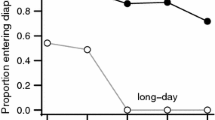Abstract
Temperate zone insect species have evolved three general strategies for synchronizing the end of hibernation with the return of favorable conditions. Recent eco-physiological studies of insect dormancy and development indicate that the prevailing concepts of the adaptations regulating hibernation and the resumption of spring activity, need revision. In particular, experimental evidence shows that despite implications in the term, dormancy is a dynamic state; the organism, by constantly monitoring the constantly-changing environmental parameters, is kept in phase with the seasons at its particular locality. Furthermore, the insect's ability to respond to environmental factors generally changes as the season progresses. Therefore, the construction of realistic predictive models of insect seasonality should be based on investigations of natural populations undergoing hibernation in the field, combined with ecologically and physiologically meaningful laboratory studies.
Similar content being viewed by others
References
CAMPBELL, A., FRAZER, B.D., GILBERT, N., GUTIERREZ, A.P. and MACKAUER, M. (1974): Temperature requirements of some aphids and their parasites. J. appl. Ecol., 11: 431–438.
TAUBER, M.J. and TAUBER, C.A. (1973): Quantitative response to daylength during diapause in insects. Nature (Lond.), 244: 296–297.
TAUBER, M.J. and TAUBER, C.A. (1975): Natural daylengths regulate insect seasonality by two mechanisms. Nature (Lond.), 258: 711–712.
TAUBER, M.J. and TAUBER, C.A. (1976a): Insect seasonality: disapause maintenance, termination, and postdiapause development. Ann. Rev. Entomol., 21: 81–107.
TAUBER, M.J. and TAUBER, C.A. (1976b): Environmental control of univoltinism and its evolution in an insect species. Canad. J. Zool., 54: 260–266.
TROTTIER, R. (1971): Effect of temperature on the life-cycle ofAnax junius (Odonata: Aeshnidae) in Canada. Canad. Entomol., 103: 1671–1683.
WILSON, G.R. and LARSEN, J.R. (1974): Debraining and diapause development inManduca sexta pupae. J. Insect Physiol., 20: 2459–2473.
Author information
Authors and Affiliations
Rights and permissions
About this article
Cite this article
Tauber, M.J., Tauber, C.A. Physiological responses underlying the timing of vernal activities in insects. Int J Biometeorol 20, 218–222 (1976). https://doi.org/10.1007/BF01553664
Issue Date:
DOI: https://doi.org/10.1007/BF01553664




